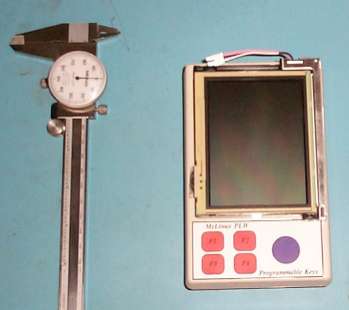Want to beta test a MyLinux PDA? Register now!
Dec 13, 2000 — by LinuxDevices Staff — from the LinuxDevices Archive — viewsRob Wehrli, project leader of the MyLinux PDA project writes . . .
The Developer Edition of the MyLinux PDA includes some special features that regular, production units do not include. This does not mean that you can not develop code and drivers on a Production Unit, rather, these units were designed primarily for initial bring-up of the Linux Kernel and low-level hardware and device driver… debugging.
The primary differences are as follows:
- EIA-485 serial port (to 11 Mbits/sec.)
- SPROM for FPGA
- Off-the-shelf plastics
- Membrane programmable function keys
- Lots of Green Wire!
- Developer Tools Source and Binary Code CDROM

Developer Edition units are designed to feature the functionality at a very low development cost. The basic idea is to get everything quickly working using as many low-cost, commercially available components. In order to quickly get units into the hands of developers so that the Open Source code base may grow, the hardware engineering team looks at Developer Edition units as hardware representations of the final product. Final product version feature things like sexy, custom designed plastics and keys, ergonomic layout of buttons and switches and contoured moldings that fit the hand. As you can imagine, custom plastic designs and toolings are very expensive. They take considerable time and money to produce. In the 6-8 weeks for a design and 12-16 weeks for tooling, a whole lot of code is written using Developer Edition units.
They certainly are not very sexy, but they're also quite a bit easier to work on! Industrial plastics designs are made to fit very snugly while shaving every last bit of unnecessary bulk out of them. Trying to open them up for debugging purposes is quite a bit more painful than popping open one of the halves of a Developer Edition unit. In fact, sometimes, we tend to just leave parts open and laying about the desktops as we connect o-scopes, LAs, serial port data capture cards and other debugging devices to the PDA.
Note that using a Developer Edition unit means experiencing BETA problems associated with Software, Hardware and other glitches that have not been completely worked out! System crashes, weird LCD “patterns” and other FUN STUFF are typical when working with a Developer Edition of the MyLinux PDA.
There is a certain degree of satisfaction that comes with “growing” a new piece of hardware into a useful product. As you turn the final version in your hand and cast an eye back to your work bench where there sits a “spread out and wired-up” Developer unit next to the first ever paper cut-outs of the board layout, your thoughts turn to the months of development, the hours spent debugging and cussing it and as you walk away from the production line where shrink-wrapped card board boxes with glossy photos contain your creation–literally built by the hands of an entire Linux Community, you glance down at the shipping label and know that the guy or gal at the other end is getting the finest piece of Linux hardware available. We call it taking pride in doing the job right, on time, on budget and on schedule.
Developer Edition units are in short supply! Our current plan is to build an additional 200 Developer Edition units by the end of March 2001. Register now, if you want to be a part of this exciting project and a permanent addition to Linux history in the making.
This article was originally published on LinuxDevices.com and has been donated to the open source community by QuinStreet Inc. Please visit LinuxToday.com for up-to-date news and articles about Linux and open source.